It’s sometimes easy to forget that a tortoise is an exotic pet. You may not need to walk a tortoise every day or change its litter box, but you’re still committing to daily care for, hopefully, many, many years to come.
While every tortoise requires research and careful planning to properly care for, some are easier to raise than others. The best pet tortoise for beginners is one that is highly adaptable, active, and (as a general rule) relatively small.
In this article, you’ll learn about the most popular tortoises for new owners and pick up some great tips and tricks for choosing the right species for your experience level.
What You Need to Know Before Getting a Pet Tortoise
There are many reasons you might want to adopt a tortoise as a pet. Tortoises are quiet and keep to themselves—no barking or scratching up the furniture—and can be a good option for animal lovers who are allergic to fur and dander.
Of course, a tortoise shouldn’t be a replacement for another type of pet. These reptiles are fascinating and engaging in their own right and deserve to be loved and cared for just as you would something like a cat or dog.
Before you decide what type of tortoise would make the best pet, you should be 100% sure that a tortoise is the right companion for you in the first place. This section goes through some of the most important things to think about before taking the next step toward getting your new pet.
Time Commitment
Tortoises can live for a very, very long time. The average domestic tortoise may live 50 years or longer, depending on the age of the tortoise when you first get it. It’s a fact that your tortoise could outlive you or, at the very least, be with you through many different phases throughout your lifetime.
But it’s not just about the years you’re committing to owning a tortoise. A tortoise requires daily care and maintenance that can take up a surprising amount of time. For example, you should be ready to stock and prepare fresh produce every day.
Space Required
A happy and healthy tortoise needs a surprising amount of space. This is why I say that smaller tortoise species typically make the best pets.
There are a few rules of thumb when it comes to how much space a tortoise needs, including:
- A tortoise needs an enclosure that is 6 times longer and wider than the tortoise itself.
- An adult tortoise needs a 40- or 50-gallon enclosure.
More space is generally better, and there are a lot of pet tortoises out there who don’t have the space they really need to thrive. Always err on the side of more.
Indoor or Outdoor?
Will your new pet tortoise live indoors or in an outdoor enclosure? The answer to this question largely depends on your local climate and the amount of space you have at your disposal.
There are only a few tortoise species that truly thrive indoors. Fortunately, most beginner-friendly tortoises fall into this category.
You might decide that your tortoise would do best living outdoors for part of the year (e.g., during the warmer summer months). This is a great plan, but it means that you’ll need to invest in and maintain two separate enclosures.
Health Needs
Accidents happen, and your tortoise may not always be 100% healthy. Before you get your first tortoise, it’s a good idea to look up what veterinary resources are available in your area. Not all vets work on reptiles and/or tortoises, so you may need to locate a specialist.
Don’t wait to do this until your tortoise needs medical attention! Planning ahead will offer much-needed peace of mind and ensure your tortoise gets the care it needs.
Cost
A pet tortoise can be expensive, even excluding the cost of a suitable enclosure and ongoing care. Some tortoise species are illegal to import from their native regions—an important step for conservation—and can only be sourced from existing breeders. The limited supply of these tortoises means that breeders can charge hundreds or even thousands of dollars.
Remember that it is always better to spend more on a tortoise from a reputable breeder. Avoid unethical breeders or importers who do not care about conservation efforts.
Are You Starving Your Tortoise?
Save 10% on premium tortoise food and supplements from Tortoise Resource Center on Amazon now using code BUYNOWGET10

Sulcata Vitamin & Mineral Topper Supplement
30-Day Supply | 2 oz (56 g)
$24.99
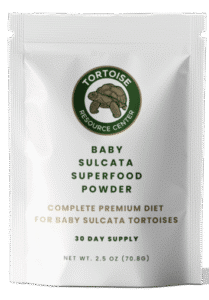
Baby Sulcata Tortoise Superfood Powder
30-Day Supply | 2.5 oz (70.8 g) Bag
$24.99
Types of Tortoises
Tortoises are typically referred to by their species (or, sometimes, subspecies) names. However, tortoise species can also be placed into groups based on things like their physical characteristics, native habitats, and taxonomy.
This section introduces you to the main types of tortoises and prepares you to learn more about which species make the best pets in the section below.
Desert Tortoises
Many tortoise species live in dry, sandy environments. True desert tortoises are burrowing tortoises belonging to the genus Gopherus. These species are native to southwestern North America, where they are a vital part of the desert ecosystem.
Desert tortoises are protected and generally not kept as pets, though it’s still legal to do so in many places.
Forest Tortoises
Most tortoises live in warm, arid places like the Mojave Desert, right? While this is true of the tortoises we usually keep as pets, there are actually a few tortoises that live in temperate and semi-tropical rainforests. These tortoises are mostly found in Southeast Asia and South America.
Forest tortoises are rarely kept as pets. These species have specific needs—e.g. high humidity—that are hard to replicate at home. Many forest tortoises are also quite large.
There’s one key exception to this rule: the red-footed tortoise native to South America. Photographs of these beautiful reptiles just don’t do them justice. Take it from me, they are even more incredible when you’re up close to them.
Mediterranean Tortoises
Nearly all pet tortoises belong to this group. Mediterranean tortoises—which belong to the genus Testudo—live in parts of Europe, Africa, and the Middle East. While some Mediterranean tortoises live in desert-like conditions, their native habitat also includes grasslands, dry forests, and rocky hillsides.
6 Great Pet Tortoises for Beginners
All tortoises require a decent level of care and attention to live long and happy lives. Some are a bit easier to care for than others, which is why we recommend these species to potential owners looking for a new companion.
1) Russian Tortoise (Testudo horsfieldii)
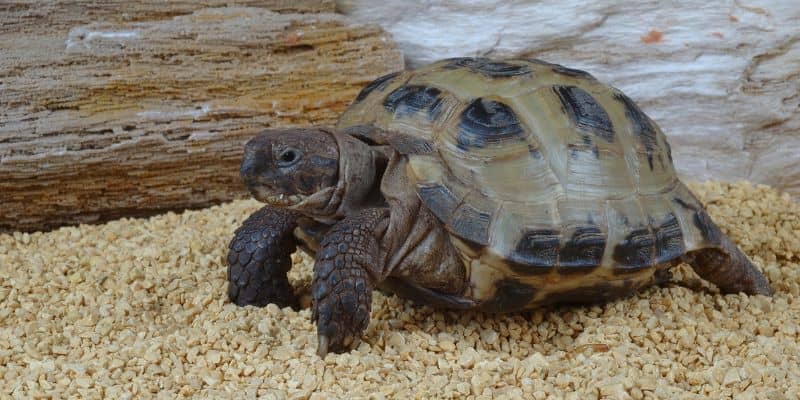
- Other names: Afghanistan tortoise, steppe tortoise, Horsfield’s tortoise, four-toed tortoise
- Conservation status: Vulnerable
The Russian tortoise is an incredibly popular pet tortoise species. Its native range extends the furthest east of any Mediterranean tortoise, covering parts of Russia, China, and the Middle East.
Russian tortoises inhabit arid hills or steppes throughout this region. These biomes are largely rocky or sandy, and the bulk of the tortoise’s diet comes from grasses and other rough foliage. Russian tortoises are exclusively herbivorous.
In the wild, these tortoises can go for more than a week without drinking water. They typically drink from puddles that form after rainstorms—a source of water that isn’t always available on a consistent schedule. (With that said, captive tortoises should always have access to fresh, clean water.)
Part of what makes this species so popular in captivity is its small, manageable size. The average Russian tortoise grows up to 10 inches long and weighs at most 2 or 3 pounds. A Russian tortoise can easily thrive in a large indoor enclosure.
There’s another reason the Russian tortoise makes a great pet: they are known for having some of the most active, friendliest personalities of all tortoises!
Wild Russian tortoises hibernate up to 5 months out of the year. In captivity, hibernation is still recommended for optimal health but may only last a couple of months.
2) Hermann’s Tortoise (Testudo hermanni)
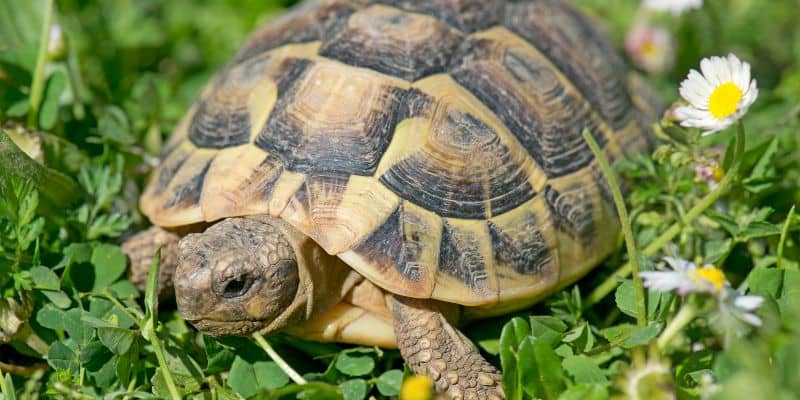
- Other names: Dalmatian tortoise
- Conservation status: Near threatened
The Hermann’s tortoise is a wonderful pet for beginners, although it’s often overlooked in favor of more popular species like the Russian tortoise. This tortoise is native to southern Europe and has a native habitat made up of rocky forests and hillsides.
There are a few known subspecies of Hermann’s tortoise, including the Dalmatian tortoise. While dalmatian tortoises are no longer recognized as a distinct subspecies (likely because wild populations have dwindled), there are still some captive breeders who offer them.
The average adult Hermann’s tortoise measures up to 7 inches long, though large females can grow up to 10 inches. While not as showy as some other species, the typical shell of Hermann’s tortoise is yellow and brown with a subtle spotted pattern.
This tortoise is a great pet in part because it has such a mild personality. Hermann’s tortoises are friendly and enjoy interacting with their owners, though they do not like to be handled.
Despite their size, Hermann’s tortoises don’t like living indoors. The best home for one of these tortoises is an outdoor enclosure that closely mimics the Mediterranean climate.
3) Greek Tortoise (Testudo graeca)
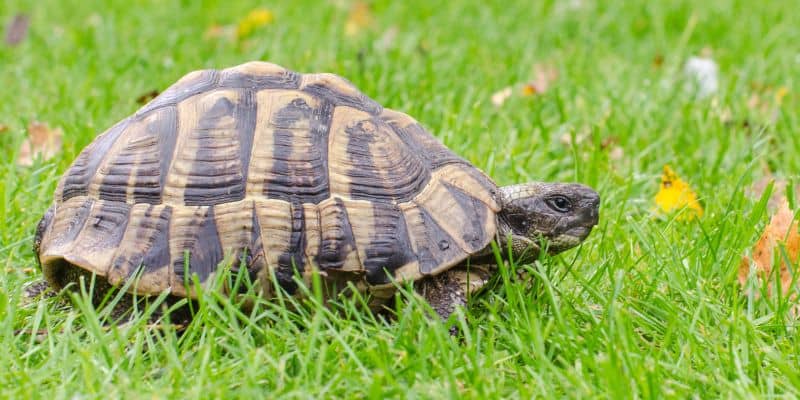
- Other names: Moorish tortoise, spur-thighed tortoise
- Conservation status: Vulnerable
Greek tortoises are small, docile, and fairly adaptable to a range of climates. These traits make them a viable option for many first-time owners who are interested in something a bit different than a Russian or Hermann’s tortoise.
Perhaps the biggest reason these tortoises are recommended as pets is their small size. Greek tortoises typically only grow to 6 to 10 inches in length, with the females being several inches bigger than the males. Greek tortoises are well-suited for both indoor and outdoor enclosures.
Greek tortoises are gentle and friendly. However, like most tortoises, they would rather stay on the ground than be handled by their owners.
Greek tortoises can live a very long time, even for a tortoise. It’s common for this species to live 75 years or longer, with some reports of Greek tortoises living to 125!
4) Red-Footed Tortoise (Chelonoidis carbonaria)
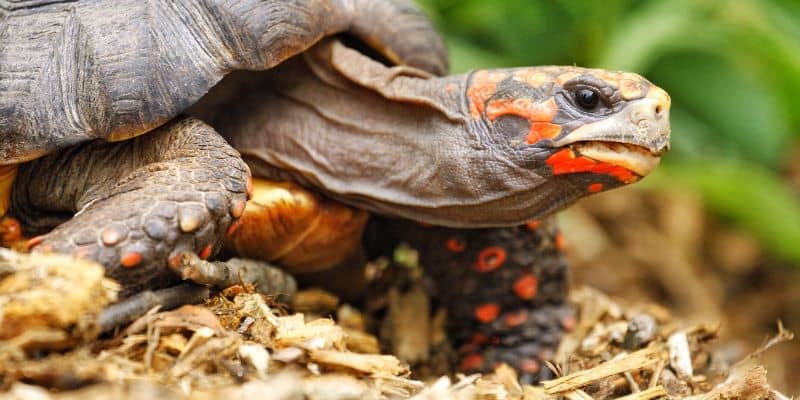
- Other names: Red-legged tortoise, cherry head tortoise
- Conservation status: Vulnerable
The red-footed tortoise is one of the only species on this list that does not belong to the Mediterranean group of tortoises. Its name comes from the red markings along its limbs and head.
Caring for a red-footed tortoise is not much different than any other species. However, these tortoises are a bit more sensitive to things like humidity, and putting together a suitable enclosure isn’t always easy. Red-footed tortoises are particularly fond of routine soaking.
Red-footed tortoises are known to be more active and even regarded as friendlier than other species. As a first-time owner, remember that it takes time for a tortoise to bond and learn to trust you. Once your new tortoise learns that you are where the food comes from, it will likely perk up any time you approach its enclosure.
5) Egyptian Tortoise (Testudo kleinmanni)

- Other names: Kleinmann’s tortoise, Leith’s tortoise, Negev tortoise
- Conservation status: Critically endangered
As the Maryland Zoo so eloquently puts it, Egyptian tortoises are ‘no bigger than baked potatoes’. The Egyptian tortoise is the smallest species of Mediterranean tortoise. It typically measures less than 5 inches long and weighs less than a pound.
Egyptian tortoises have high, domed shells and are usually a light shade of tan all over. This pale coloring reflects the sunlight, enabling the tortoise to survive in the extreme desert heat.
Egyptian tortoises live in a dry habitat characterized by frequent morning fog. Many owners find that their tortoises enjoy a mister or fog machine set up on a daily timer. Make sure the enclosure gets warm enough during the day to completely dry out.
Even in captivity, these tortoises tend to be most active at dawn and dusk. Egyptian tortoises like to take shelter in small burrows or under rocks, so be sure to provide an enclosure that allows your new pet to feel safe and comfortable.
6) Leopard Tortoise (Stigmochelys pardalis)
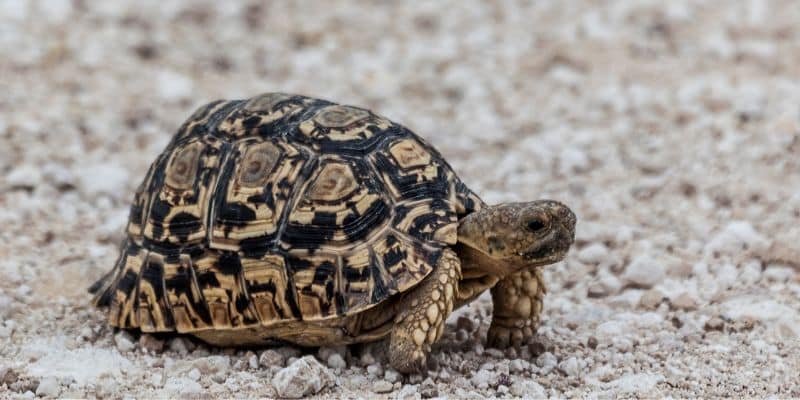
Conservation status: Least concern
The leopard tortoise is quite famous because of its decorative, spotted shell. The shells are like snowflakes—each one is unique. It is the only member of its genus.
Leopard tortoises are native to the African savanna, where they wander and graze on various grasses. This tortoise doesn’t burrow on its own (except to lay eggs), but will sometimes take shelter in holes left by other savanna wildlife.
As one of the largest living tortoise species in the world, the leopard tortoise can grow up to 30 inches long and weigh over 80 pounds. The typical leopard tortoise is about 15 to 20 inches long and weighs about 30 pounds—a much more manageable size. An average maximum lifespan ranges from 80 to 100 years.
While pretty, the leopard tortoise shouldn’t be kept indoors (at least not year-round). Instead, these tortoises thrive in outdoor enclosures in warm, arid climates. Their lack of burrowing means they rarely damage landscaping around their enclosures, unlike many other tortoise species!
Adult leopard tortoises should never be left out in temperatures below about 60°F, so plan to bring your pet indoors if the temperature drops. Alternatively, you can invest in heated outdoor housing for protection from the occasional cold spell.
Next Steps Before Getting a Pet Tortoise
You’re not done yet. Choosing a type of tortoise is just one of the first steps toward becoming a bona fide tortoise owner!
Here are some of the next steps to take as you prepare to welcome a tortoise into your home and become the best owner possible for your future pet.
Connect to ethical breeders
A tortoise is not a pet you should just pick up at the local pet store. After narrowing down the species you think will fit you best, your next step is to find and connect with trusted breeders of that species. Some captive breeders might have waitlists for a tortoise.
Join local tortoise groups
There may be other tortoise owners in your area! Search for local enthusiasts who can recommend ethical breeders and answer any questions you might have. A great place to start is your local reptile supply store.
In-person groups are wonderful but not always a reality. You can also connect to other tortoise owners online using social media like Reddit, Facebook, or Slack.
Find a trusted veterinarian
You don’t want to end up with a sick or injured tortoise and no one who can help. Reptiles are harder to treat than many other pets (most vets just don’t see them very often), so you can’t always count on taking your tortoise to the local vet clinic.
There might not be a reptile specialist in your area. If that’s the case, you’ll want to learn basic tortoise first aid and stock up on the necessary supplies. Keep contact information for the closest specialist on hand in case of an emergency.
Keep learning
You don’t need to learn everything about tortoises before getting your new pet. With any luck, you’ll have many years to continue learning about your tortoise and how to give it the best life possible!
Citations
- All Pets Veterinary Hospital Tortoise care sheet
- California Turtle & Tortoise Club Russian Tortoise
- Maryland Zoo Egyptian tortoise
- Egyptian Tortoise – Prof Dr Norman Ali Khalaf by cc 4.0


